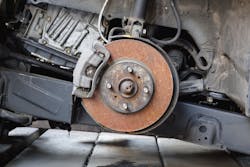Proper brake system performance is critical to ensure vehicle safety. So critical, in fact, that throughout North America, there are comprehensive programs dedicated to commercial vehicle brake safety.
In August, which is National Brake Safety Month, the Commercial Vehicle Safety Alliance has scheduled its Operation Air Brake Safety inspections for the last full week—Aug. 23 to 29. While checking brake safety components is always part of the roadside inspection process, this year inspectors will be paying special attention to brake hoses and tubing.
During a July 21 FleetOwner webinar, sponsored by Penray, Penray’s chief chemist Steve Muth and heavy-duty director of sales Greg Mixon discussed national brake safety, the importance of routine brake maintenance, and traits users look for in brake and parts cleaners.
“Brake safety is all about prevention,” Muth said. “Repairs after an accident don’t do you any good. A vehicle that won’t start is a problem, but a vehicle that won’t stop is a danger. It’s all about preventive maintenance. The number of vehicles negatively affected by the inspection process is significant. Vehicles are taken out of service due to brake inspection failures. Proper maintenance keeps trucks safe and on the road at the same time by helping people pass these inspections.”
On-road safety is directly dependent on the condition of the brakes and tires, Muth pointed out. He advised that pre-inspection cleaning can help reveal problems.
“A quick spray down with brake cleaner to remove dirt and oil buildup makes it a lot easier to check drums, motors, friction material, and moving parts, such as the slack adjusters or calipers, on braking systems,” Muth said. “There are a lot of moving parts that need to be kept clean during operation, lubricated as necessary, and maintained in their proper condition. Brake cleaner will help with all these services and operations.”
“Obviously, brakes need to be in good operation for emergency highway stops and panic stops,” he added. “But they also need to have smooth operations for precision maneuvers like backing into a dock.”
When it comes to maintenance, proper tools are a necessity. Muth said that in addition to wrenches, screwdrivers and pry bars, service chemicals are important. These include grease, penetrating oil, and brake cleaner.
“Brake cleaner should be right there with the rest of your tools—from start to finish of the job,” he said. “You will use it for initial cleaning and inspection of the systems, and you’ll use it to prep replacement parts, as a lot of parts come with an oily or waxy coating and rust during storage.”
Brake cleaner also can be used when the service of a truck is done to clean up overspray from draining oil. And when it comes to roadside inspections, enforcement officers will appreciate clean brakes and systems and well-maintained equipment overall.
Brake cleaner performance
There are two primary traits to look for in brake cleaner performance, explained Muth. The first is effectiveness and how well it cleans. Second is the efficiency of its cleaning.
Because there are various kinds of dirt and debris encountered when technicians are doing a maintenance job, removing all the grease and oil requires a strong solvent for ease of cleaning. According to Muth, that’s where the brake cleaner comes in.
“While cleaning is number one on the list of things that brake cleaners do, there are other things that contribute to the performance, as well as the perception that people have of the product,” Muth said. “Some of the things people look for are faster drying time and quicker, more efficient service so technicians are not waiting for parts to dry.”
Some non-performance attributes, such as smell, also contribute to the way technicians use the product, Muth pointed out.“Different people think of chemicals in general in different ways. Some think stronger smell indicates a more powerful product. Others are concerned about working with overpowering chemical odors all day,” he said. “To reduce chemical contact in general, a quick cleaning leads to shorter exposure as well as faster repairs. Even the sound of the product coming out of a can will affect the way people think of the product.”
In addition, Muth said it’s not unusual for brake cleaners to be used as multipurpose parts cleaners.
“Brake cleaners are great degreasers, but they need to be treated with respect,” Muth advised. “Brake cleaners contain strong solvents and harsh chemicals, some of which are actually poisonous and can be absorbed through the skin. Non-chlorinated brake cleaner is flammable. The fumes that are generated by spraying out such a flammable solvent into the air can travel a long way, and technicians need to be aware that these fumes traveling potentially along the ground can reach other bays where they could be ignited and cause a flash fire. These are serious chemicals and they need to be treated as such.”
Chlorinated and non-chlorinated brake cleaners
The primary difference between non-chlorinated and chlorinated brake cleaners is flammability. Non-chlorinated brake cleaner is extremely flammable, which is why many technicians use chlorinated brake cleaners, Muth noted.Chlorinated brake cleaners, however, can and generally will contaminate waste oil. Some fleets won’t let chlorinated chemicals into their maintenance shops because they know at some point they will end up in their waste oil drum.
Muth also said that technicians can predict the performance of a brake cleaner, to some extent, from the chemicals listed on the label or the safety data sheet. Acetone and methanol are popular solvents listed on these labels.
Due to its chemical structure, acetone does not contribute to air pollution or smog in a significant way, Muth added. However, it’s a poor degreaser, so technicians might have to use much more of it to get the job done.
Then, there’s methanol. “It’s not much of a better cleaner than water and it can really kill a product’s degreasing ability,” Muth explained. “It’s cheap filler and will reduce the cost of a can by a few cents. You can always spot it by the skull and cross bones on the label. If there’s methanol, it will say poison.”
In addition, some states have reduced the amount of volatile organic compounds—known as VOCs—that can be included in brake cleaner formula. Although these chemicals contribute to air pollution, they’re much more efficient cleaners, Muth said.
VOCs are emitted as gases from certain solids or liquids. They include a variety of chemicals, some of which may have short- and long-term adverse health effects.
Mixon added that several states cite aerosol products as serious contributors to pollution. Several products were found to be less likely to contribute to pollution and smog—acetone is one of them. It is a good solvent and cleaner, but not the best degreaser, he explained.
“The more serious we get about protecting the environment, which is very important, the more difficult it is to make safe, effective cleaning solvents—and that means brake cleaners,” Mixon said.





